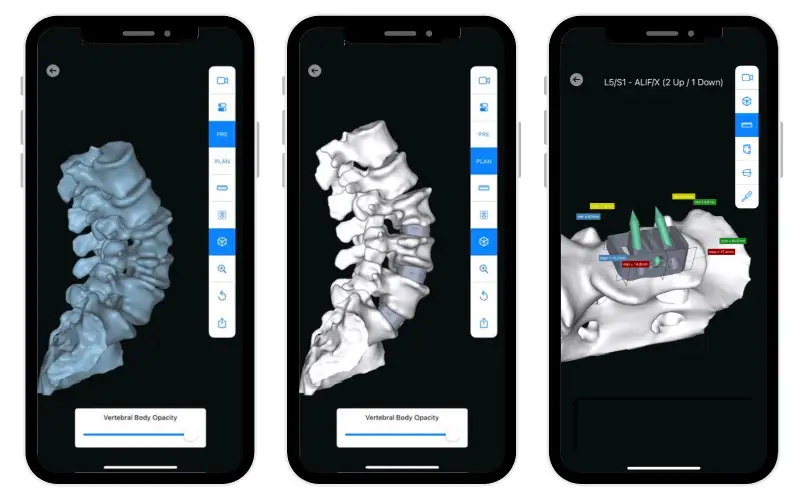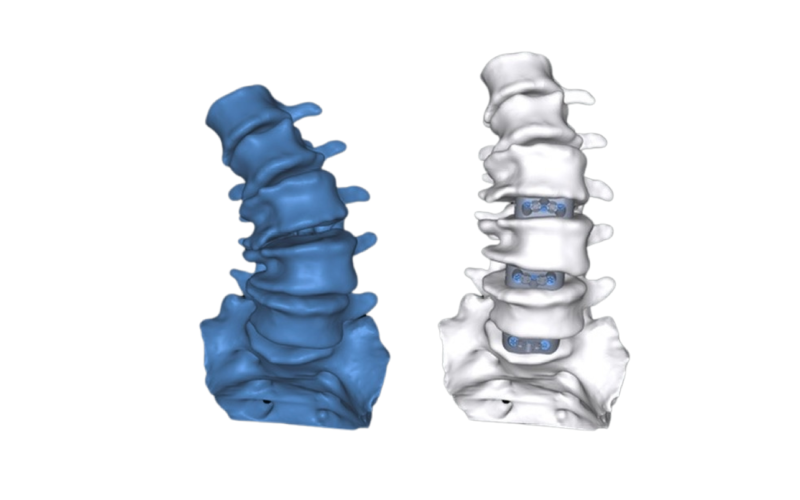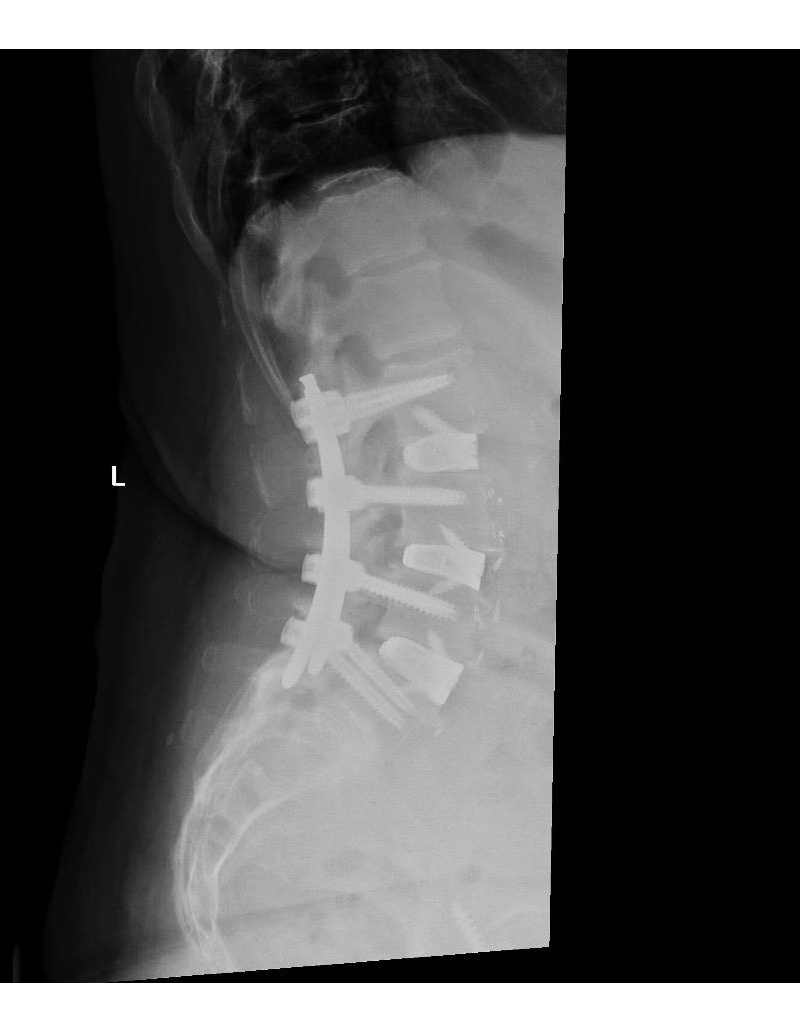Circumferential minimally invasive (MIS) lumbar fusion is a complex surgery that stabilizes the spine and relieves pain by implanting cages in the spinal discs to fuse the vertebrae. Stock prefabricated implants come in standard sizes, which do not precisely match the 3D topography of a patient’s vertebral bones. Failure to match the unique surface topography of each patient’s bones decreases implant stability and can result in a failure to achieve a successful fusion. Furthermore, edges of the stock cages may erode through the bone leading to a condition called subsidence.
As another concern, sometimes surgeons use cages to straighten out a patient’s scoliosis. However, standard implants do not allow a surgeon to correct spinal deformities in the coronal plane precisely—especially if an asymmetric or non-standard shaped graft would result in the most ideal correction.
Andrew K. Chan, MD, co-director of Minimally Invasive Scoliosis Surgery at Och Spine at NewYork-Presbyterian and Columbia, is using the latest technology in spine surgery to overcome those challenges: artificial intelligence (AI) and 3D printing. Below, Dr. Chan discusses performing the first MIS lumbar fusion in New York using 3D-printed personalized interbody devices and how this AI technology could be used more broadly in the future.
How the Patient Presented
I had a 75-year-old patient who had been putting off her lumber spine surgery for a long time. She had scoliosis with severe spinal degeneration from L3 to S1 and had already tried multiple non-operative strategies, including epidural steroid injections, physical therapy, and medications. Her next step would be a MIS lumbar fusion, and I felt that she would be a good candidate for this approach given the asymmetries in her bones and her need for correction in the curve of her spine.
The Surgical Planning Process
Using the patient’s CT scan, I worked with a manufacturer to create a 3D image of her lumbar spine using AI. AI helped to determine the optimal alignment of her spine and shifted her bones into their ideal positions. Afterwards, three personalized devices were created to fill in the gaps between the bones, taking into account the patient’s unique bony surfaces. I then reviewed the plan and spoke with the engineers about any needed adjustments.

The AI-enabled planning software generates personalized alignment plans and patient-specific device designs that are reviewed, refined, and approved by each surgeon through a mobile 3D visualization platform. Photo credit: Carlsmed, Inc.
Once I approved the plan, the manufacturer fabricated the personalized devices using 3D printing. The result was an implant designed specifically for the patient’s bone shape and the goals that we were trying to achieve through surgery: decompression of the nerves and re-establishment of normal spinal alignment. Achieving ideal spinal alignment is important as it helps to prevent additional surgeries and other areas of the spine from breaking down in the future.
Benefits of Personalized Devices
Personalized devices that are a perfect fit for the patient’s spine have several benefits. First, they decrease the risk of subsidence, the phenomenon when a poorly fitting cage can erode into the bony endplate. When that happens, you may get symptom recurrence. Secondly, they allow for optimal biomechanical stability which promotes a successful fusion. With this, patients will have a lower risk of reoperation due to non-fusion of the vertebrae or loosening of the screws and/or rods. The way these personalized devices fit in the bone eliminates the imprecision that can be seen with traditional implants. It really is the future; it’s a game changer.

AI-generated patient-specific 3D spine models of a patient’s pre-operative spine (blue) and the personalized planned alignment (white). Photo credit: Carlsmed, Inc.
The Procedure
Her surgery took place as planned – I performed a three-level circumferential MIS fusion and placed the personalized devices at the three different levels, which perfectly fit her anatomy. Because we implanted the personalized devices in the front of the spine, we didn’t have to make a large incision in the back of the spine or disrupt the back muscles. Instead, I was able to place screws via small incisions and pass a connecting rod underneath the muscle. This is in contrast to traditional “open” surgery which requires a more extensive muscular dissection that can lead to more pain and a longer recovery. Everything went smoothly, and she has been recovering extremely well.
How AI Will Transform the Future
I’ve already completed multiple cases using these personalized, 3-D printed devices. There are a few other centers across the United States who are also starting to use these devices. I think it has the potential to become the standard of care for lumbar fusions.

X-ray showing the interbody case implanted into a patient. Each patient-specific device is manufactured through 3D titanium printing technology and provided sterile in a surgical kit to the hospital.
I believe that AI has extraordinary potential in medicine, and I’m already starting to implement this technology across various spine procedures. Currently, I’m approaching complex minimally invasive scoliosis surgery not only using patient-specific interbody devices but also other AI-driven technologies including patient-specific rod implants. During MIS scoliosis surgery, I pass the personalized rod underneath the muscle and reduce the spine to that rod shape. By serving as a template for the patient’s ideal correction, the personalized rod gets me the exact planned correction. This is particularly useful in MIS spinal deformity surgery since the rod is “hidden” underneath the skin and I do not have access to additionally bend the rod like in open surgery when the entirety of the spine, screws, and rods are exposed.
I’m also using AI in research to help determine which patients are likely to have the best outcomes and what factors help predict those outcomes. It’s really a 360-degree experience in terms of how I leverage AI for our patients: before clinic, during clinic, in the operating room, and in the research realm.




